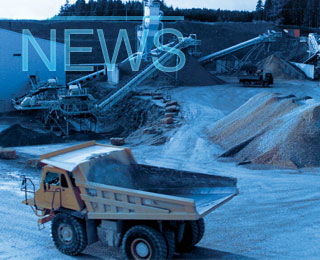Romanian cement manufacturers will hang their hopes on a market up turn on industrial construction projects and new logistic centres, but the outlook is not encouraging for domestic manufacturers after another year of declines in cement sales.
The Romanian cement market is expected to drop by between three and five per cent in 2013 as both residential and non-residential constructions stall. This means another year of decline after the market shrank by 0.2 per cent in 2012 on 2011. No growth perspectives are so far in sight for 2014, and should the industry lose its access to the EU’s free CO2 allowances scheme, the economic viability of doing business in Romania will come under threat, warn manufacturers.
Existing infrastructure projects were not enough to drive up the local cement market in 2013 either. Factoring in that the number of building permit applications for residential and non-residential buildings will fall again in 2013 as they have since the beginning of the crisis.
“In 2011 and 2012 we had a boost from infrastructure projects such as Corridor IV works, and we continued to benefit from some of these projects in 2013, but we do not see any infrastructure projects of significant size that would drive demand next year,” said Daniel Bach, CEO of Holcim Romania, last week.
“I don’t think the Romanian construction market will ever again see annual increases of 7-9 per cent like those posted over 2005-08. But I am confident that a moderate yet stable and constant growth rate of about one to two per cent per year is achievable,” Florian Aldea, general director and president of the board of directors at Carpatcement Holding, said in May. Judging from how things are looking at present, growth perspectives lie beyond 2014. “I would expect 2014 to be similar to this year in terms of activity. We don’t assume a further drop but we believe that the risk of decline is probably slightly higher than the possibility of growth,” added Bach.
Any positive impact could come from the non-residential sector, such as the development of industrial projects and logistics centres, but demand for this is fuelled by export activities, which in turn depend on the economic evolution of western Europe, Romania’s main export market.
Even if the economic situation turns around, should the European Union (EU) drop the free CO2 allowances scheme for cement producers, the market will come under considerable strain, thinks Holcim Romania’s CEO. At present, a number of industries, including cement producers, which are at risk of suffering a competitive disadvantage in relation to imports, get free CO2 emission allowance certificates. Local producers will see increased competition from producers in Turkey, Ukraine and Russia, who don’t have to bear such costs.
The continuation of the free CO2 allowances scheme is vital, stressed Mihai Rohan, president of CIROM, the Romanian cement producers association. “Otherwise we will build our infrastructure using Ukrainian cement,” he said.
Holcim is still investing its Romanian operations and last week it opened a EUR15m waste heat recovery installation for its factory in Alesd. The investment will be recovered in 10 years, forecasts the firm. The installation produces electricity using the gases resulting from the cement production process and will generate about 15 per cent of the electricity the factory uses. It is the first of this kind in eastern Europe, said Bach.
“There is an opinion that we should buy green certificates for the energy we produce in this installation, when it should be the opposite. Of all the green energy, what we produce is the greenest. We don’t see why we should be punished by having to buy green certificates for the energy we produce. I think they simply forgot to include this in the law,” said Bach.
Another local cement factory will open a similar installation, but if the authorities require producers to buy green certificates for the electrical energy they produce, there will be no incentive for them to make similar investments, added Rohan.
Holcim Romania will see its sales fall for a second consecutive year. This will be in line with the general three to five per cent contraction of the cement market, said Bach. The company has increased prices this year (by two to three per cent), but this will most likely not offset the drop in volumes, he added. On the other hand, Holcim says it will return to a similar profit level to the one reported in 2011. Last year Holcim Romania made a EUR8.5m loss, but much of this was generated by several write-offs, added the CEO. Last year’s sales brought EUR213m in turnover, below the EUR223m reported in 2011 and considerably down on the EUR372m record level posted in 2008.

Cement prices recovering in China
Cement prices in China are rebounding strongly as producers seek to improve profitability follow...